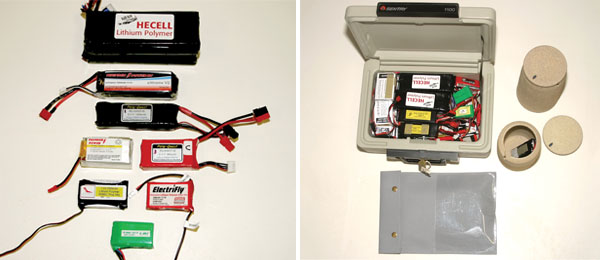
Written by Jay Smith and Rachelle Haughn Storing and disposing of your batteries As seen in the Winter 2018 issue of Park Pilot
>> It is that time of year when many pilots put their aircraft and supplies in temporary storage as the cold weather sweeps in. For those who fly electric aircraft, batteries are an important part of their equipment. Proper storage of your LiPo batteries should ensure that they are ready for flying season. Park Pilot would like to share a few tips for storing and recycling batteries.
Battery storage: If storing a LiPo battery longer than one week, it should be stored at 3.8 to 3.9 volts per cell (approximately 50% charged). Storing a fully charged LiPo battery can affect its capacity loss over time. Many chargers on the market have a built-in storage charge/discharge function. Select this option on the charger, input the battery parameters, and let the charger do all of the work!
According to Thunder Power RC (thunderpowerrc.com), the optimum temperature to store batteries is between 40° and 70° F and they should not be exposed to direct sunlight for an extended period of time.
It is also a good idea to cover the connectors or ensure that multiple connectors cannot come in contact with one another and possibly cause a short. Caps can be purchased to cover many popular connector brands.
Commercially available products that can be used to store your batteries include the LipoSack, LiPo Battery Bunker, or even an ammunition can. If you are using an ammunition can, remove part of the seal or drill small holes in the top to allow for venting in the event of a LiPo battery discharge or fire.

Caps can be purchased that will cover many popular connectors and prevent a short.

Batteries should be stored at 3.8 to 3.9 volts per cell, approximately 50% charged. The optimum temperature to store batteries is between 40° and 70° F and out of direct sunlight.
If your rechargeable batteries have reached the point where they no longer hold a charge, have lost 20% of their capacity, or have puffed, it’s time to say your goodbyes and recycle them.
Call2Recycle (call2recycle.org) is a battery collection program that collects and recycles rechargeable batteries. It will recycle your NiMH, Li-Ion (Lithium Ion), LiPo, and NiCd batteries that weigh up to 11 pounds (New York’s weight limit is 25 pounds) for free. There are approximately 30,000 participating public collection sites across the US and Canada.

Call2Recycle provides free battery collection at many popular retailers. Drop-off locations can be found on the organization’s website. Best of all, the batteries are recycled.
The collection sites are conveniently located at retail stores, small businesses, and municipalities. In the state of Indiana, where AMA Headquarters is located, drop-off sites include Sears, Lowe’s, True Value, Ace Hardware, Staples, Home Depot, HobbyTown USA, and solid waste districts.
Finding a drop-off center located near you is simple. All you need to do is visit the Call2Recycle website and type in your ZIP code. This action opens a map showing the closest drop-off locations. If you don’t have access to the internet, you can call (877) 273-2925 in the US or Canada.
A battery collection box is at each drop-off site. All batteries that are intended to be recycled must be individually bagged to ensure that the terminals cannot touch. Puffed battery packs can be recycled as long as the structural integrity has been maintained, they are bagged, and the terminals are protected.

Many products, such as the LipoSack, can be used to safely charge and store your batteries.
Why should you recycle your aircraft’s batteries when it’s more convenient to throw them in the trash? Before you toss them, you should know that some states have passed laws making it illegal to dispose of certain types of rechargeable batteries and cellphones in the regular trash. New York, North Carolina, New Mexico, California, and others have such laws in place. You can find more information about each state through the Call2Recycle website.
After the batteries have been collected, the chemicals in them are used to make new ones. The cadmium in NiCd batteries can be used as a stiffening agent in materials such as cement, and the nickel is reused in stainless steel products.
In its more than 20 years of existence, Call2Recycle has diverted millions of pounds of rechargeable batteries from landfills. In 2016, more than 14 million pounds of batteries were recycled instead of being tossed into landfills. In California alone, more than 1 million pounds of batteries were recycled, and collections in Canada climbed to an all-time high of 4.4 million pounds.
Call2Recycle is funded by major product and battery manufacturers that want to ensure that the batteries and cellphones they sell are recycled. Call2Recycle does not accept single-use/disposable or automotive batteries. A detailed list of what batteries can be accepted is found on the Call2Recycle website.

If you are using an ammunition can for charging or storing LiPo batteries, you can remove part of the seal or drill small holes in the top to allow for venting in the event of a battery discharge or fire.
Photos by Park Pilot staff Written by Jay Smith and Rachelle Haughn





